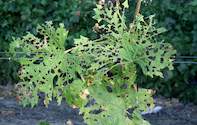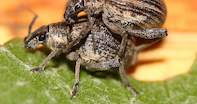The most common snout beetle in wine grapes is the Phlyctinus callosus. The insect attacks the buds, leaves, vine shoots and grape bunches and eats holes in the leaves and shoots.

Monitor the vines early in the season regularly for possible damage or the appearance of snout beetles. As it moves from the ground to the trunk, a shoot is often left low against the trunk to serve as a warning of nutritional damage. Snout beetles appear in vineyards all year long, but leave the vines as soon as the leaves fall to feed on a weed such as curly dock - a prestigious host plant.

Any snout beetle control should be done according to IPW regulations (Integrated Production of Wine Scheme). For example, the scheme recommends systemic pyrethroids should not be sprayed.
These insecticides have a very wide spectrum that is detrimental to some of the vineyard pests’ natural enemies. This can also lead to the outbreak of secondary pests such as the red spider mite. A study has shown that two different snout beetle species can be controlled by sticky trunk barriers.
By Vinpro